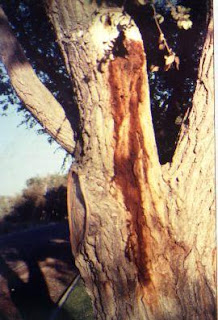 |
| Elm leaf beetle damage |
A. There is no airborne disease of elms that you have to worry about. I think there is some confusion about Dutch Elm Disease and these trees. Siberian elms are not as susceptible to DED as some other elms which are not planted here anyway.
Most of the elms here are Siberian elms, an inferior elm for landscape purposes. By the way, one of my favorite large trees is Chinese or Evergreen elm, a very nice tree that grows well in our climate with very few problems.
The usual disease problem we see on Siberian elm is a relatively harmless disease called slime flux. This is a bacterial disease which invades the wood and causes basically fermentation inside the trunk and large limbs. ooze from the bacteria is pushed out of the trunk or limbs and weeps down the side of the tree frequently from a pruning cut. If you get close to this ooze it will smell like fermentation or yeasty.
 |
| Wetwood or slime flux comig from pruning cut |
This smell frequently attracts flies to the ooze. It is thought that the flies can pick up this bacterial contamination and spread it to new wounds on several trees besides Siberian elm. If we see this particular disease on the tree we usually ignore it since it really does not cause any long term ill effects.
As far as insects go the worst problem is elm leaf beetle which skeletonizes the leaf. We usually ignore this too since it usually does not cause severe damage to the tree but does cause the leaves to become unsightly. These trees are tall/large with the leaves very high in the air so damage to them is usually ignored. It would be very costly to spray these trees to control this problem.
The last problem we have had with Siberian elm is when older landscapes with these elms growing in lawns is converted to rock landscapes. Frequently there is not enough water applied for these trees to continue to be healthy and the branches die back due to lack of water and a poorly designed irrigation system for the elm to survive.
The dutch elm disease is devastating to older dutch elm. I have seen quite a few that have needed treatment right away to prevent them from being destroyed. The treatments have become much more productive in adding years to the trees lives.
ReplyDeleteJust a note, the comment above on DED or Dutch Elm Disease originated from an arborist in Minnesota where DED has been devastating to American Elms and some of their relatives. You might check the the Nevada State Dept of Agriculture or Arizona Department of Agriculture where DED in those states is very rare to non existent. Also I might add the name Dutch Elm Disease is in reference to where the disease in elm was first confirmed, the Netherlands, not to a specific type of tree (Dutch Elm).
ReplyDelete